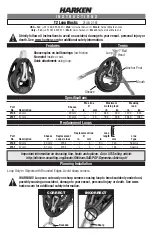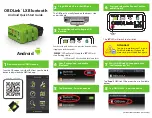
(EN) ENGLISH
Nomenclature of parts
(1) retainer, (2) attachment point,
(3) housing, (4) braking surface
Checking, points to verify
Before use, check the body of the REVERSINO.
If there is any doubt about the condition of the device,
return it to PETZL for inspection.
Instructions for use
Intended use
The REVERSINO is a belay device for the leader or
second, for use with double dynamic ropes of small
diameter (2 half ropes or 2 twins), EN 892. When
attached to the belay using the attachment point (2),
it may be used in self-locking belay mode to belay
one or two seconds.
It may also be used to rappel.
Diagram
1 : Installation
Clip a locking HMS carabiner to the retainer (1).
- Attach the carabiner to the belay loop of the
harness.
- Insert two loops of rope into the slots formed by the
housing of the REVERSINO,
- Clip the loops and lock the carabiner.
Diagram
2 : Belaying the leader
The belayer must be securely anchored before
belaying a partner. It is important to place a
directional anchor for the leader’s rope.
- Giving slack. The hand on the free end of rope
pushes upwards, forming a loop. The hand on the
active rope is used to pull through rope as necessary.
- Taking up slack. Use the hand on the free end of the
rope to take up slack.
- Arresting a fall. Hold the free end of the rope fi rmly,
keeping the hand low. Before use, take time to test the
REVERSINO in a safe environment with your rope to
get a feel for how much force it is necessary to exert
on the rope in order to arrest a fall. The use of gloves
is recommended.
Diagram 3 : Belaying the second
Do not proceed until you are securely attached to the
belay.
3A. Belaying the second without the self-locking
feature.
Install th
e rope in the REVERSINO as shown in
diagram 1. The second’s rope must be redirected
through the belay. Use this technique to belay a
second when it may be necessary to give slack
(on a traverse, for example).
3B. Belaying the second in self-locking mode.
- using the attachment point (2), attach the
REVERSINO to the belay with a locking carabiner.
- Insert two loops of the rope into the slots formed
by the body of the REVERSINO (the active end of the
rope positioned above the free end).
- Clip the loops of rope and the retainer (1) with a
locking HMS carabiner, and lock the carabiner.
- Verify that the rope is properly installed by pulling
on the active (climber’s) end ; the rope should jam in
the REVERSINO.
With both hands, slide the rope smoothly through the
system. If the second falls, the system jams the rope
and arrests the fall. It is very important to always hold
the free end of the rope. The device must be able to
operate freely at all times. Its operation must never be
impeded by contact with the cliff or other obstacle.
WARNING : it is not possible to give slack with the
rope under tension. A good knowledge of mechanical
advantage techniques is required to unlock the
system (see www.petzl.com).
Diagram 4 : Using the self-locking mode to
belay two seconds climbing together
WARNING when belaying 2 seconds climbing
together :
- Preferably use a rope certifi ed as single rope
for each second. In this case, you cannot use the
REVERSINO. You must use a REVERSO.
- You may use one strand of rope certifi ed as double
rope for each second. But there is more risk of cutting
the rope on a sharp edge.
- It is absolutely forbidden to use one strand of a twin
rope.
Warning : when belaying two seconds, if one of the
two seconds is hanging on the rope, it is necessary to
pay close attention to the rope on which the other is
climbing (4A).
Small rope diameters (8 mm to 8,5 mm), the
condition of the sheath (new, dry fi nish, wet, icy) and
the position of the carabiner (4B) can disable the self-
locking function. Taking up slack steadily, ensuring
that the carabiner remains correctly positioned and
fi rmly gripping the two ends of rope help to reduce
the risk.
Diagram 5 : Switching leads
When the second arrives, he attaches himself
securely to the belay. The belayer moves the
REVERSINO from the belay to his harness (set up as
in diagram 1). In this manner, the second becomes
the leader. It is important to run the leader’s rope
through a directional anchor.
Diagram 6 : Rappelling
Install the two ends of the rope in the REVERSINO as
shown in diagram 1. Depending on your weight and
the diameter of the rope, apply more or less braking
force. A second carabiner may also be used. Use a
backup system (Shunt or Prusik). Tighten your grip
on the free ends of the rope to slow the descent.
Diagram 7 : Occasional rope climbing
Install the REVERSINO in self-locking mode as
indicated in diagram 7.
4
Notice REVERSINO
D16
réf. : D16500-A

























